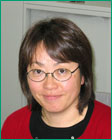Efforts to establish equality between the sexes are gathering strength at RIKEN and as one of its female researchers; this trend certainly has piqued my interest. Before joining RIKEN in July 2004, I taught psychology at Duke University in the state of North Carolina. All told, I have spent nearly 20 years studying or working at American universities. I would like to share my observation of how American universities attempt to address gender issues.
My research fields, linguistics and developmental psychology, attract a large number of female researchers. The advance of female researchers in these disciplines is so noticeable that we sometimes joked that "We should invite male candidates to avoid being called sexist during recruitment. Females are well represented in the student bodies as well, so that I felt that women must not have so much difficulty being active members of the community. Support for maternity and childcare is substantial. Maternity leave is paid and child-care readily available. In fact, both parents are able to take leave for child-care. In addition, parental responsibilities, including daycare arrangements, are taken into consideration when determining meeting schedules. Faculty members with children also have their children's need considered for other faculty events that might shift their work responsibilities over to others, but no one is complaining. The attitude that housework is no longer considered the exclusive work of women, and men commonly boast of their skills in the kitchen. It is easy to hire a babysitter or a house cleaner to further reduce the burden of housework. Recently, for those who can afford it, live-in nannies from abroad are increasingly common.
However, these conveniences are not available everywhere. Women working in the departments with few female staff, such as physics or mathematics, complain about their situations. These disciplines have few female senior researchers; sometimes there may be just one or two young female researchers in a faculty of 40. In such environments, a female faculty often feels uncomfortable in requesting maternity or child-care leaves, and giving appropriate career advising to their female students is problematic.
There is a difference in support received by tenured or tenure-track professors and those outside of the tenure system in American universities. Tenure guarantees faculty members access to and support from those systems that are in place to support female staff. However, staff occupying non-tenure-track posts is ineligible for these services. At Duke University, for example, Medical School researchers, who are supported by their own grants, and as well as other research staff who are hired by these labs, are also not always able to take advantage of programs that could support them. Careers for such researchers could end should ill health jeopardize a grant review because research results are less than satisfactory. These researchers are expected to apply for unpaid sick leave if they become pregnant, and they might find that there is no post to return to after childbirth. Natural science researchers such as medicine and biology commonly take several short-term post-doctorate positions. These positions are highly mobile, and influence marriage and child raising decisions. Does the couple or family move together or live separately as positions change?
Other non-tenured staff at universities that teach students include lecturers who are hired for a limited term and part-time instructors. As the number of tenure-track posts continues to decline to reduce personnel costs, these limited term positions are increasing. Part-time lecturers are under severe constraints, financially and amongst their peers. They usually teach a large number of classes for low remuneration. While serious for both sexes, it is harder on women wanting children. Female researchers are known to push themselves very hard to continuing working, or forced to resign against their wishes. I feel that American universities are being polarized. Tenure-track professors are enjoying the accommodating the environments that have improved significantly over the years, while other researchers are subjected to harsh, marginalized positions that impact lifestyle.
It was not that long ago that female professors gained the status they enjoy today in American universities. While working on my doctorate at Cornell University in New York, I met Professor Eleanor Gibson in the department of psychology. She was one of the world's top developmental psychologists and started research in infant cognitive/perceptual development. She was married to James J. Gibson, an authority on visual perception research. Upon entering the Graduate School of Psychology at Yale University, Gibson asked a professor to join his laboratory. He turned her away, saying, "My laboratory does not need a woman. Even after arriving at Cornell with her husband, it took her decades to get her own laboratory because the university did not employ married couples within the same department. She conducted her research in the animal laboratories on a farm attached to the Agricultural School. I was surprised by her experiences, and realized how recently they had happened within the lifetime of the pioneering researcher in my field standing in front of me.
While at Cornell, an American researcher of Japan said in a lecture that Chie Nakane remains the only female professor at the University of Tokyo. However, in recent years, the number of female faculty is increasing in Japanese universities. It is not uncommon to find female professors around my age taking very active roles in the faculties of major universities. At BSI, too, the range of activities for women is expanding. Several laboratory heads and unit leaders are women. While I would like to see the number of female researchers increase further, I know that there are still many problems to be solved before a more favorable environment is created to enable this. However, we should remember that the present environment emerges from the hardships of our senior female researchers only a few decades ago. We should find inspiration in this and strive to make greater improvements for those female researchers of the future who will inherit our legacy.






